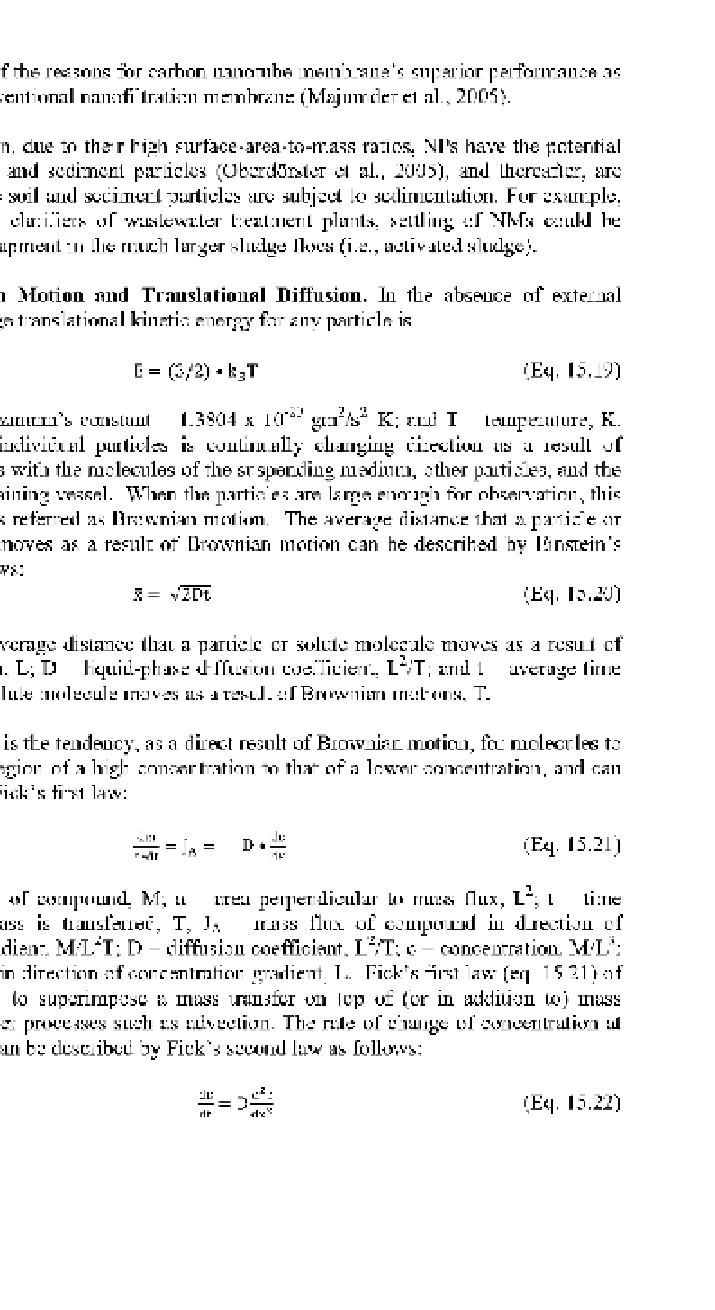Environmental Engineering Reference
In-Depth Information
reported as one of the reasons for carbon nanotube membrane's superior performance as
compared to conventional nanofiltration membrane (Majumder et al., 2005).
In addition, due to their high surface-area-to-mass ratios, NPs have the potential
to adsorb to soil and sediment particles (Oberdorster et al., 2005), and thereafter, are
removed as these soil and sediment particles are subject to sedimentation. For example,
in the secondary clarifiers of wastewater treatment plants, settling of NMs could be
enhanced by entrapment in the much larger sludge floes (i.e., activated sludge).
Brownian Motion and Translational Diffusion.
In the absence of external
forces, the average translational kinetic energy for any particle is
E = (3/2).k
B
T
(Eq. 15.19)
where ks = Boltzmarm's constant = 1.3804 x 10"
2
0
gm
2
/s
2
-K; and T = temperature, K.
The motion of individual particles is continually changing direction as a result of
random collisions with the molecules of the suspending medium, other particles, and the
walls of the containing vessel. When the particles are large enough for observation, this
random motion is referred as Brownian motion. The average distance that a particle or
solute molecule moves as a result of Brownian motion can be described by Einstein's
equation as follows:
x= V2Dt
(Eq. 15.20)
where x = the average distance that a particle or solute molecule moves as a result of
Brownian motion, L; D = liquid-phase diffusion coefficient, L /T; and t = average time
that particle or solute molecule moves as a result of Brownian motions, T.
Diffusion is the tendency, as a direct result of Brownian motion, for molecules to
migrate from a region of a high concentration to that of a lower concentration, and can
be described by Pick's first law:
where m = mass of compound, M; a = area perpendicular to mass flux, L ; t = time
during which mass is transferred, T; JA = mass flux of compound in direction of
concentration gradient, M/L
2
T; D = diffusion coefficient, L
2
/T; c = concentration, M/L
3
;
and x = distance in direction of concentration gradient, L. Pick's first law (eq. 15.21) of
diffusion is used to superimpose a mass transfer on top of (or in addition to) mass
transfer from other processes such as advection. The rate of change of concentration at
any given point can be described by Pick's second law as follows:
^=D^|
(Eq. 15.22)
dx
2
vi
/
dt

Search WWH ::

Custom Search